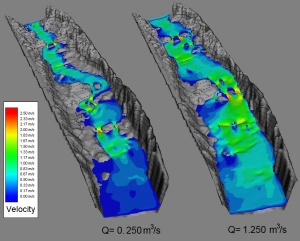CSDMS 2014 annual meeting poster Angel Monsalve
Including sediment patches in sediment transport predictions in steep mountain channels
Elowyn Yager, University of Idaho Boise Idaho, United States. eyager@uidaho.edu
Abstract:
Spatial variability in grain size, roughness and sorting generated by bed surface patches impact bedload transport by altering the relative local mobility of different grain sizes and creating complex local flow fields. In high gradient mountain channels large roughness elements bear a significant portion of the total shear stress available for motion and the remaining shear stress acts over patches of more mobile sediment. The shear stress on mobile patches has a distribution of values that depend on the local topography, patch type, and location relative to roughness elements and the thalweg. Current sediment transport equations do not account for these variations of roughness, local flow, and grain size distributions on and between patches. Often they use an area-weighted approach to obtain a representative grain size distribution and reach-averaged shear stress and by doing so they lose important characteristics that affect sediment transport estimations. Such equations also do not distinguish between active (patches where at least one grain size is in motion) and inactive patches and do not include differences in mobility between patch classes that results from local hiding effects and spatial shear stress distributions. We hypothesize that predictions of sediment transport must explicitly include different patch classes and local variations of the flow field. We modified Parker’s (1990) bedload transport equations to use distributions of shear stresses, measured grain sizes, and a specific hiding function for each patch class. A reach averaged sediment transport rate was calculated considering the contributions of all the different patch classes. To test this hypothesis we calculated the distributions of shear stresses over a range of patch classes in a 40 m long, 10% gradient step-pool stream. We surveyed the bed with a high density resolution (5 cm in horizontal and vertical), mapped and classified patches by their grain size distributions, and measured water surface elevations and mean velocities for low to moderate flow events. With these data, using a quasi-three dimensional model (FaSTMECH), shear stress distributions were calculated over each patch for a range of flow discharges. Shear stress distributions varied between different patch classes and also changed for different discharges. Sediment mobility in patches was highly dependent on the patch’s class and location relative to the thalweg and large roughness elements. Predicted bedload transport rates more closely matched measured values when patch classes instead of individual patches were used. More accurate bedload predictions were obtained if the shear stress distribution shape was allowed to change with discharge. Compared to deterministic formulations, the use of distributions of shear stress and bed grain sizes significantly improved predictions of bedload transport in a steep mountain channel.

* Please acknowledge the original contributors when you are using this material. If there are any copyright issues, please let us know and we will respond as soon as possible.
